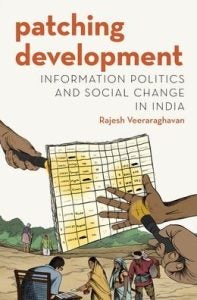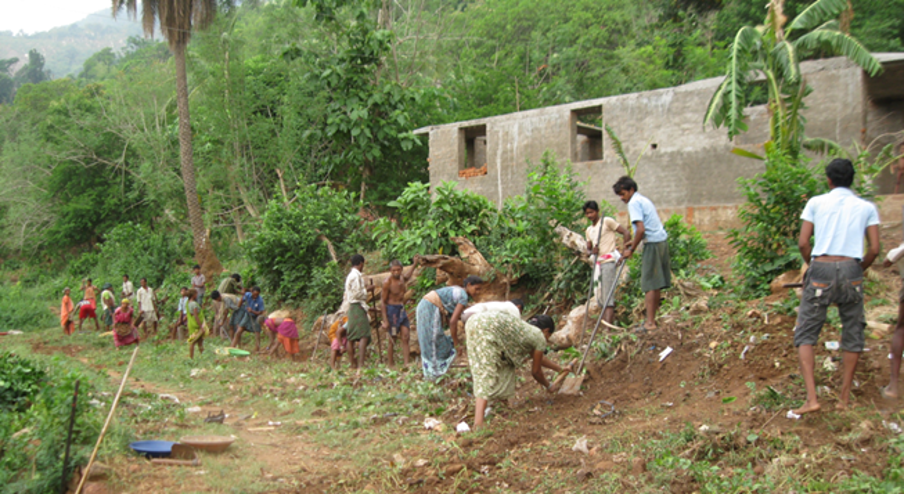New book explores the interplay of technology, information, institutions and social dynamics in rural India
When STIA Professor Rajesh Veeraraghavan decided to volunteer in India during the summer of 2010 while pursuing his Ph.D. at the University of California, Berkeley, he did not anticipate the lasting impact this experience would have on his research.

In India, he volunteered alongside activists to perform a social audit of government archives from the Indian National Rural Employment Act (NREGA), one of the largest development programs in the world, in Araria, Bihar. He began to wonder how many other villages had unexamined records and whether or not the state government could examine these records, rather than independent actors such as activists. He heard the oft-repeated statement that money does not reach the intended beneficiaries. He wondered whether this process of social audits could scale to other villages? This question later formed the basis of his Ph.D. dissertation and his newly released book, Patching Development: Information Politics and Social Change in India.
Veeraraghavan’s research examines NREGA by investigating its implementation in the South Indian state of Andhra Pradesh. Broadly, this book is about the politics of a state bureaucracy using information and technology to implement a developmental program on the ground. The book’s central focus is on the role that information and technology can play in overcoming what he calls “last mile” implementation challenges. In social development programs, “the last mile” refers to the final part of delivering goods or services to marginalized citizens. Broadly, this book is about the politics of a state bureaucracy using information and technology to implement a developmental program on the ground. Patching Development also explores the role of information technology within broader government initiatives. The book explores the question: How can development programs deliver benefits to marginalized citizens that expand their rights and freedoms? Under what conditions and how does the state react most effectively to the local exercise of power at the ‘last mile’ of implementation? What role can information and technology play in the implementation?
Researching NREGA
NREGA is a social program implemented by the National Indian government that guarantees the right to work to all rural workers. Under this program, employment essentially becomes a right for all citizens. Passing NREGA through the legislature was a product of a struggle of social movements, bureaucrats, activists, and politicians. The program was designed, with insights from experimentations in social development over the years as well as input from activists, bureaucrats, politicians, and academics.
Yet, implementing large-scale programs such as NREGA is difficult due to the size, Andhra Pradesh’s state capacity, and NREGA’s potential for government corruption. The study is based on an eighteen-month deeply engaged ethnographic research in the southern state of Andhra Pradesh, the state which is viewed by many to have the most successful implementation of the Act. Veeraraghavan characterizes the relative success of Andhra Pradesh’s implementation to the process of “patching development,” a process in which high-level bureaucrats must continually adapt their policies and implementation based on local feedback. This process strengthens the power that high-level bureaucrats have over lower-level bureaucrats while reducing the power of local elites over workers. The idea of describing this process as “patching” first came to him when he was sitting in the office of the rural secretary in Hyderabad, the former capital of Andhra Pradesh. Veeragrahavan says, “patching is about the fight over power in the last mile.”
To write the book, Veeraraghavan used a variety of approaches including participant observation, interviews, content analysis of documents and government archives, and a survey that was administered in fifteen different villages. During his time researching, Veeraraghavan lived and sometimes “worked” alongside NREGA workers as well as conducted interviews with bureaucrats, activists, and politicians. He also attended social audit meetings and examined documents from the Andhra Pradesh legislative sessions to observe how government officials talked about the NREGA program.
The Politics of the Minutia
Veeraraghavan argues that the main takeaway of the book is that the focus on the politics of implementation deserves full scholarly and policy attention in order to effectively implement welfare programs. He chose to study a case where there was a strong political and bureaucratic will to implement the program. In other words, the program was well-designed thanks to work from social movements, bureaucrats, and activists. Yet, he shows that while political will and good design of policy are critical, implementing complex, big programs in an unequal setting often have to deal with resistance from local power systems. Reformers do not have the capacity to fundamentally change this power through direct confrontation with local elites. The local system of power is hard to transform, not because of inertia, but because of counter-strategies from powerful actors at the local last mile. These problems often require multiple attempts at fine-tuning and adapting to local concerns. He argues that last mile problems need to be understood politically, not technically.
An example that Veeraraghavan uses to illustrate this process is the problems officials faced while creating attendance rolls at worksites. When initially signing people up for projects, local officials took attendance on paper. Later, a computer operator entered the information into a computer; however, this practice often led to the fudging of numbers by the computer operator. The program readjusted to the field assistants entering the data on mobile phones, which simply led to the field assistants boosting attendance themselves. To address this supervisors were assigned to audit the attendance rolls with geocoded locations that were automatically checked against the workplace locations. Problems never reach a steady-state and continue needing new adaptations and patches. This process of constantly adapting to local-level problems is essential to patching. Fundamentally, patching is not just about changes in technology but also changes in governmental institutions and processes that seek to address resistance in the implementation. He argues that focusing on seeming ‘technical’ details is not a technocratic act, but an extremely political process that needs to be recognized as such to prevent sabotage at the last mile.
The Global Implications of Andhra Pradesh
Although the book’s primary audience is academic circles, Veeraraghaven also hopes that it will resonate with policymakers and the general public. The story of Andhra Pradesh resonates on a global level as a result of the interplay between government and technology. He emphasizes that people cannot have a “deterministic faith” in technology to solve all problems; but, at the same time, technology could have a political use. Veeraraghavan writes that technology will not create a technocratic utopia; instead, it provides more tools to policymakers and increases the potential for democratic participation in social development. This potential means contesting power through the focus on the minutiae of how documents are maintained, what records can be made read-only, where to conduct public meetings, whether to read out findings, and democratizing access to government records. Andhra Pradesh serves as a successful model of a development program at a time when there are increasing global calls to eliminate welfare programs due to the struggles of implementation. The process of patching development demonstrates a possibility in which these challenges can be overcome and struggles at the last mile have the potential to change relations with the state and within society.
Check out the book on Amazon .
